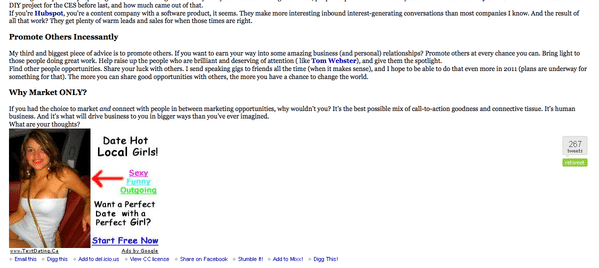
This morning, I received the latest post from a popular blogger via the blog’s email subscription service, which runs on Feedburner.
The post talks about marketing and how relationships and connections are a key part of the marketing mix (and can often be the starting point for any marketing campaign).
It’s a good post with a sensible message. What caught my attention, though, was a Google Ad at the bottom of the post, which is the image at the top of this post (and, yes, I’m a man and, no, the scantily clad young girl wasn’t why the picture caught my attention).
It’s a prime example of why you need to be careful of how your message is being shared, and why automated monetizing can (potentially) backfire.
Adventures in Keywords
A lot of bloggers look at ways they can monetize their blogs. One way is through affiliate marketing; another is through products; another is through running related ads via Google, which is what’s happened here.
The way this works is you set up a Google Ads account and set them to run automatically with your content. This could be your blog’s sidebar, the blog post itself, or (in this case) the subscription feed. Google looks at the keywords in the blog, and automatically inserts what it thinks are relevant ads.
In the post used here, a lot of the talk is about “connections” and “relationships”, so they’re seen as keywords. Throw in the odd “touchpoints” and “love”, and Google probably thought the blogger was talking about dating – hence the accompanying image and ad.
And that’s where the problem of automation can rear its ugly (or scantily-clad) head.
Your Readers Are Listening
When you subscribe to a blog by email, it’s because you’re really interested in what a blogger has to say. You’re investing in them, and giving over real estate in your Inbox as opposed to just catching up now and again via an RSS feed. It’s showing your trust in that blogger’s voice.
Because of this, you might think that an ad like the one in this example is something the blogger has attached to that post by choice. And that can cause problems.
A lot of people could be offended by the image and the message it portrays. Others could be receiving the email at their workplace, and potentially break any rules about adult images on-screen. Or you could be the girl’s parents opening the email…
It’s not (directly) the blogger’s fault – the choice was made by Google, not the blogger. But it’s an image that’s gone out from a highly-respected blog, with more than 60,000 subscribers, and it’s attached to a marketing message on how to do business right.
Yet through a simple error on keywords, the message of the post could potentially be diluted. Additionally, if the ad was worse, it could also lead to some readers unsubcribing (depending on the trust built up for the blog in question).
Something you might want to keep in mind when considering automating your readers’ content…


![[Research Round-Up] New Study Shows the Continuing Value of B2B Thought Leadership](https://customerthink.com/wp-content/uploads/development-2010010_1280-pixabay-innovation-ideas-think-1-218x150.jpg)
